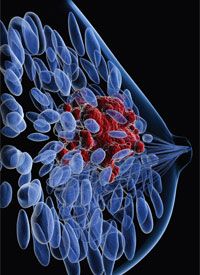Trastuzumab Deruxtecan Is Active in HER2 Low-Expressing Breast Cancer
The novel HER2-directed antibody-drug conjugate trastuzumab deruxtecan-nxki demonstrated promising antitumor activity in patients with heavily pretreated, HER2 low-expressing advanced or metastatic breast cancer.

The novel HER2-directed antibody-drug conjugate (ADC) trastuzumab deruxtecan-nxki (Enhertu; DS-8201) demonstrated promising antitumor activity in patients with heavily pretreated, HER2 low-expressing advanced or metastatic breast cancer, according to findings from a subgroup analysis of a first-in-human, phase 1b study published in the Journal of Clinical Oncology.1
The agent, which has a topoisomerase I inhibitor payload, elicited an objective response rate (ORR) of 37%, according to independent central review (ICR; 95% CI, 24.3%-51.3%). Additionally, the median duration of response was 10.4 months in this patient population (95% CI, 8.8—not evaluable [NE]).
In December 2019, the FDA granted an accelerated approval to the ADC for the treatment of adult patients with unresectable or metastatic HER2-positive breast cancer who have received at least 2 prior anti–HER2-based regimens in the metastatic setting. The accelerated approval was based on data from the phase 2 DESTINY-Breast01 trial, in which T-DXd induced an ORR of 60.3% per IRC (95% CI, 52.9%-67.4%).2
The dose-escalation portion of the phase 1 study included 54 patients with advanced HER2 low-expressing breast cancer who received at least 1 dose at 5.4 mg/kg (n = 21) or 6.4 mg/kg (n = 33) dose of T-DXd. Treatment was administered intravenously once every 3 weeks barring patient withdrawal, unacceptable toxicity, or progressive disease.
Patients were enrolled from the United States (n = 27) and Japan (n = 27) and had a median age of 56.6 years (range, 33-75).
Two-thirds of patients had an ECOG performance score (PS) of 0, while the remaining third had a score of 1. Additionally, the median time from initial diagnosis of HER2 low-expressing breast cancer was 105 months.
Patients included in this study were heavily pretreated with a median of 7.5 prior lines therapy. Of these prior therapies, 83.3% of patients received 5 or more prior treatments, 29.6% received prior CDK4/6 inhibitors, 18.5% received prior HER2-targeted therapy, 18.5% received prior trastuzumab (Herceptin), 13% received prior pertuzumab (Perjeta), 9.3% received prior ado-trastuzumab emtansine (T-DM1; Kadcyla), and 1.9% received an alternative therapy.
In addition, the majority of patients (88.9%) underwent prior cancer-related surgery.
Regarding HER2 expression as determined by immunohistochemistry (IHC), 48.1% of patients had 2+ expression while the remaining 51.9% had 1+ expression. Additionally, 87% of patients were hormone receptor (HR)–positive.
At baseline, 63% of patients had bone metastases. Moreover, 53.7%, 25.9%, and 9.3% had metastases to the liver, lung, and brain, respectively.
The subgroups in which T-DXd led to favorable ORRs were in patients with 1+ expression, those with HR-negative disease, who had the treatment at the 5.4 mg/kg dose level, those with prior HER2-directed therapy and no prior CDK4/6 inhibitor therapy, an ECOG PS of 0, and patients in the United States.
Additionally, the median progression-free survival was 11.1 months, and the median overall survival was 29.4 months (95% CI, 12.9-29.4).
Regarding safety, 53 of 54 patients experienced at least 1 treatment-emergent adverse effect (TEAE). The most common all-grade TEAEs occurring in at least 30% of patients included nausea, decreased appetite, diarrhea, alopecia, vomiting, anemia, constipation, fatigue, white blood cell count decrease, platelet count decrease, and stomatitis.
In both dose-level cohorts, the most common reason for treatment discontinuation was progressive disease which occurred in 42.9% of patients treated with 5.4 mg/kg of T-DXd compared with 48.5% of those treated with 6.4 mg/kg of T-DXd. In the overall patient population, the median treatment duration was 6.1 months.
Grade 3 or greater TEAEs occurred in 63% of patients and were mainly hematologic and gastrointestinal in nature. The most common grade 3 or higher TEAEs occurring in 5% or more of patients included neutrophil count decrease, white blood cell count decrease, anemia, hypokalemia, platelet count decrease, aspartate aminotransferase decrease, decreased appetite, febrile neutropenia, cellulitis, and diarrhea.
One patient experienced 2 separate grade 1 infusion-related reactions. However, these were resolved within the same day of onset. Moreover, no patients experienced a decrease in ejection fraction.
Three toxicity-related deaths were reported. Two of these deaths were due to pneumonitis while the other was due to interstitial lung disease (ILD).
ILD is a potentially worrisome TRAE in patients with HER2-positive breast cancer. In this study, 11 potential incidences of ILD were observed. Of these, 8 were adjudicated as T-DXd-induced ILD by the independent adjudication committee. Notably, 7 of these 8 events were experienced by patients from Japan.
“It is difficult to compare rates of ILD because there is variation in factors, including study populations, ILD definition, and measurement methods,” lead study author Shanu Modi, MD, of Memorial Sloan Kettering Cancer Center, and co-investigators wrote. “Reported incidence of grade 1 events could be linked to frequency of chest imaging because these events are mainly diagnosed through imaging and are otherwise asymptomatic. Patient demographics may also affect observed ILD rates because ILD incidence for many drugs is higher in Japan than in other countries. Similar to patients with HER2-positive breast cancer, ILD was less frequently observed with 5.4 mg/kg versus 6.4 mg/kg. Analyses across multiple studies of T-DXd are further characterizing the risk and potential predictors of drug-related ILD.”
To further evaluate the activity of T-DXd, the randomized phase 3 DESTINY-Breast04 trial (NCT03734029) is currently underway, comparing the efficacy and safety of the 5.4 mg/kg dose of T-DXd versus physician’s choice of capecitabine (Xeloda), eribulin (Halaven), gemcitabine, paclitaxel, or nab-paclitaxel (Abraxane) in patients with unresectable and/or metastatic HER2 low-expressing breast cancer.
References:
- Modi S, Park H, Murthy RK, et al. Antitumor activity and safety of trastuzumab deruxtecan in patients with HER2-low–expressing advanced breast cancer: results from a phase Ib study. J Clin Oncol. 2020;38(17):1887-1896. doi:10.1200/JCO.19.02318
- Modi S, Saura C, Yamashita T, et al. Trastuzumab deruxtecan in previously treated HER2-positive breast cancer. N Eng J Med. doi:10.1056/NEJMoa1914510



